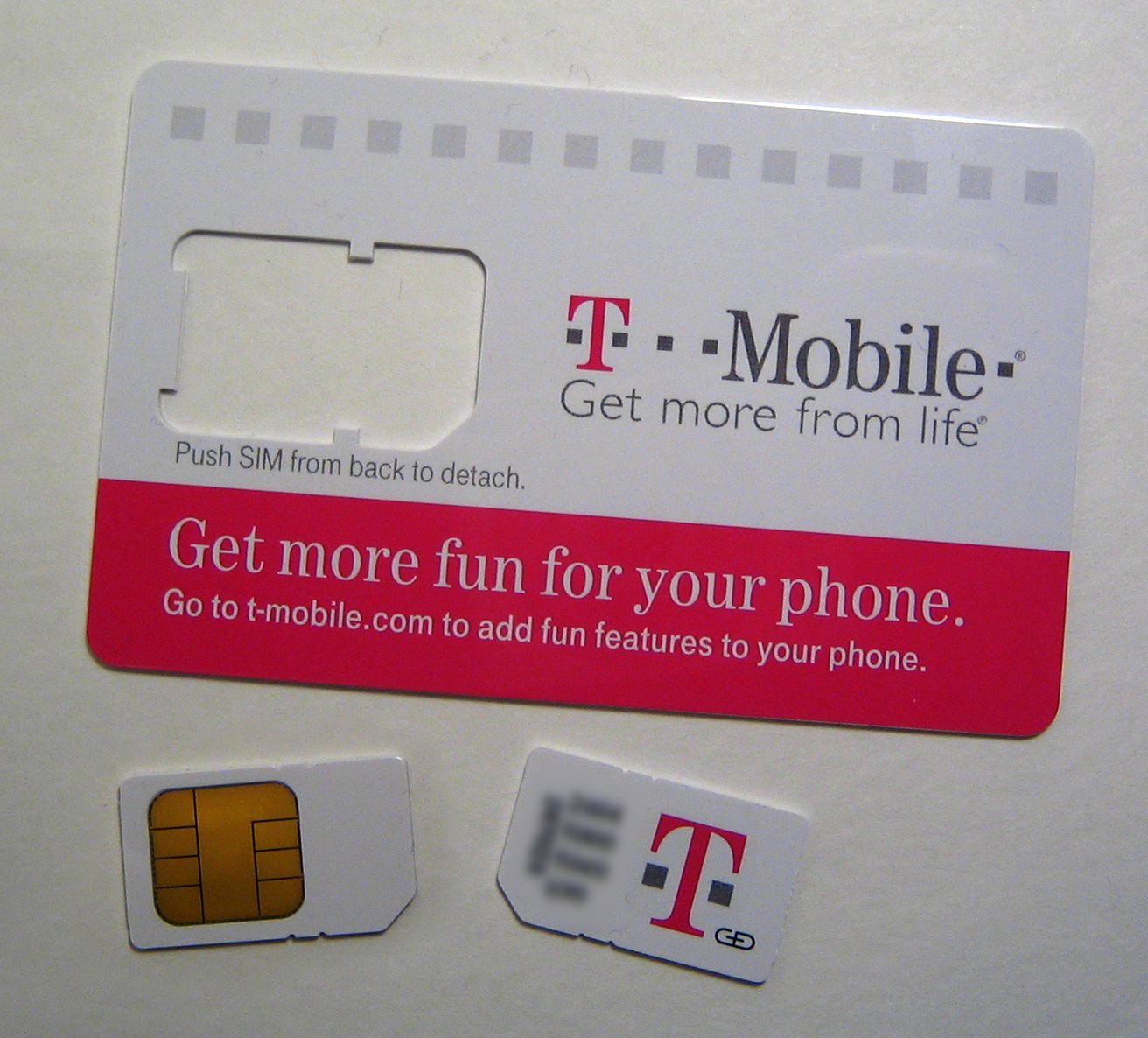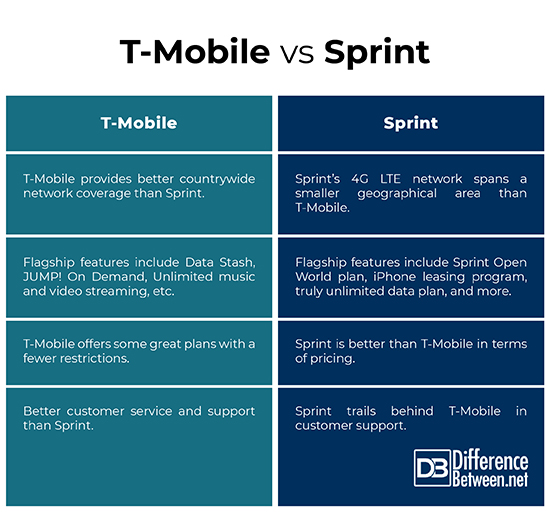Difference Between T-Mobile and Sprint
Network carriers are the leaders of the wireless world; without network operators there would be no networks. Given the rise of equipment vendors like Apple and Samsung and the increasing use of mobile devices in m-commerce, it’s easy to say mobile operators continue to play the pivotal role in enabling world’s digital future. Technology has evolved at an unprecedented rate and so does the telecommunication landscape with it, but the role of mobile companies has remained the same or that the market has not changed. In addition, mobile operators are also the means through which other companies access customers. Network carriers are still the primary players in the mobile market and leading the race are two major players of the mobile communications landscape – T-Mobile and Sprint. Both are two of the dominant network operators and wireless service providers in the United States by subscriber base. Let’s see how the two network carriers stack up in terms of pricing, coverage, customer service, etc.
What is T-Mobile?
T-Mobile is one of the largest cellular operators in the world and the dominant wireless service provider in the United States. It is the mobile telecommunications subsidiary of German telecommunications company Deutsche Telekom. Headquartered in Bellevue, Washington, T-Mobile is the third largest wireless service provider in the United States. T-Mobile has redefined the way consumers and businesses leverage wireless services through leading products and services. The business of T-Mobile has grown rapidly in a dynamic and evolving market over the last few years. This enabled the company to maintain the critical focus and control required to create value from investments in a multinational business environment. The company now serves over 76 million people. T-Mobile is pursuing an acquisition of Sprint for months.
What is Sprint?
Sprint Corporation, or Sprint, is the fourth-largest mobile carrier and wireless service provider in the United States. It provides wireline and wireless communications products and services to consumers, businesses, and government organizations, through its subsidiaries under the Boost Mobile, Assurance Wireless, and Virgin Mobile names. The long-distance business of Sprint was born in January 1970 when the Southern Pacific Company (SPC), the holding company controlling important railroad properties, established it to provide private-line communications services to businesses, government agencies, and educational institutions. In 1982, GTE Corp. proposed a deal to buy SPC’s long-distance telephone operation, including Sprint. GTE Sprint was gradually purchased by United Telecommunications, a large operator of local telephone systems, and in 1990 officially adopted Sprint as its name. Sprint was the first national wireless carrier to actually test, launch and market 4G technology.
Difference between T-Mobile and Sprint
Network Coverage for T-Mobile vs. Sprint
– Both T-Mobile and Sprint are the leading wireless service providers in the United States. However, T-Mobile leads the competition with a much larger consumer base of over 76 million people and a better countrywide network coverage than Sprint Corp. Sprint is the fourth-largest mobile network carrier in the United states, behind T-Mobile. While both deliver a comprehensive network, neither can beat Verizon and AT&T in terms of network coverage, delivering nationwide service. Sprint’s 4G LTE network spans a smaller geographical area than other carriers including T-Mobile.
Pricing of T-Mobile and Sprint
– T-Mobile offers some great plans with a fewer restrictions and the right combo of features and add-ons. The carrier’s flagship unlimited plan start at $70 per month for the first line which drop further to $50/month for the second line and an extra $20/month for an additional line with the AutoPay turned on and up to a maximum of eight lines. It also offers an AutoPay discount of $5 per month per line. Sprint, on the other hand, offers some great value plans starting from $50/month for the first line and $40 for a second, while the third, fourth, and fifth are complimentary. Sprint is the way to go, when it comes to pricing.
Customer Service of T-Mobile and Sprint
– While both T-Mobile and Sprint provide excellent customer service and support through their consumer-focused customer support team, T-Mobile seems to rank a little higher on the consumer satisfaction metrics. Thanks to its team of experts program which put extra effort into their customer service, T-Mobile offers the best customer support, allowing customers to connect to the right person the second they call in for assistance. Sprint, on the other hand, is losing out on customers’ trust with its inconsistent LTE coverage which fails to impress customers, let alone customer support.
Features in T-Mobile vs. Sprint
T-Mobile offers the best value with its Un-carrier model, providing customers with a new streamlined plan structure based on their needs, allowing users to carry forward their unused data from one month to another. And the best part, it keeps the unused data on hold for up to 12 months. With T-Mobile’s Binge On and Music Freedom programs, you can stream as much video and music as you want without adding it to your current 4G LTE data plan with absolutely no additional cost. Sprint also offers a comprehensive set of features to appeal to the general customers, including its flagship Open World plan, which offers customers unlimited free calling and text from the US to Canada, Mexico, and other Latin American countries.
T-Mobile vs. Sprint
Summary of T-Mobile vs. Sprint
Both T-Mobile and Sprint are two of the dominant network operators and wireless service providers in the United States, providing wireless voice, message, and data services to individuals, businesses, and government agencies in the United States. While T-Mobile offers reliable and comprehensive network coverage countrywide, Sprint offers the best-value plans which offer the best value for your money. Both are good service providers and they provide some great plans to best suit your needs. If you need a better network coverage and customer support, T-Mobile is the ultimate winner in the category. While if pricing is your concern, then Sprint is the way to go.
- Difference Between Caucus and Primary - June 18, 2024
- Difference Between PPO and POS - May 30, 2024
- Difference Between RFID and NFC - May 28, 2024
Search DifferenceBetween.net :
Leave a Response
References :
[0]Image credit: https://upload.wikimedia.org/wikipedia/commons/thumb/1/13/Logo_of_Sprint_Nextel.svg/500px-Logo_of_Sprint_Nextel.svg.png
[1]Image credit: https://commons.wikimedia.org/wiki/File:T-Mobile_SIM_card_front_and_back.jpg
[2]Stone, Alan. How America Got On-line. Boca Raton, Florida: CRC Press, 2015. Print
[3]Burbank, Jack L., et al. Wireless Networking. Hoboken, New Jersey: John Wiley & Sons, 2013. Print



